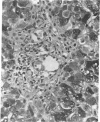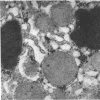Abstract
Studies were carried out in a family in which two children with cholestasis due to intrahepatic bile duct anomalies were shown to have increased amounts of the cholic acid precursor, 3alpha, 7alpha, 12alpha-trihydorxy-5beta-cholestan-26-oic acid (THCA). The metabolism of THCA was studied in one of these patients after an intravenous injection of (3H)THCA, and the cause of the increased amounts of THCA in this condition was found to be due to a metabolic defect in the conversion of this compound into cholic acid. A small amount of (3H)cholic acid was also identified after (3H)THCA administration, confirming that this metabolic defect was incomplete. Varanic acid (3alpha, 7alpha, 12alpha, 24xi-tetrahydorxy-5beta-cholestan-26-oic acid), a metabolite of THCA, could not be identified in either of these patients. By assuming that this compound would be conjugated and excreted if the metabolic block occurred after the formation of varanic acid, the defect in these patients appears to be due to a deficiency of a 24-hydroxylating enzyme system required to convert THCA into varanic acid. This condition appears to be transmitted in an autosomal recessive fashion, because the two affected patients were of opposite sex, and neither a normal sibling nor the two parents have increased amount of THCA in their bile.
Full text
PDF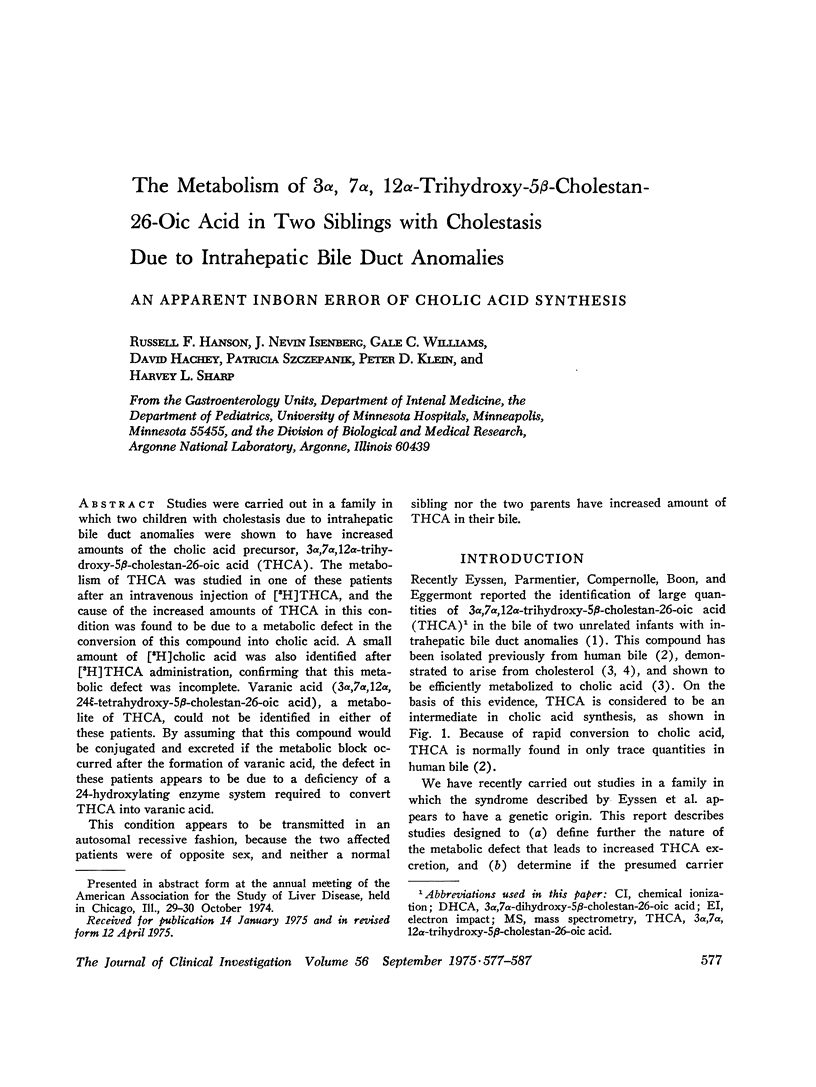
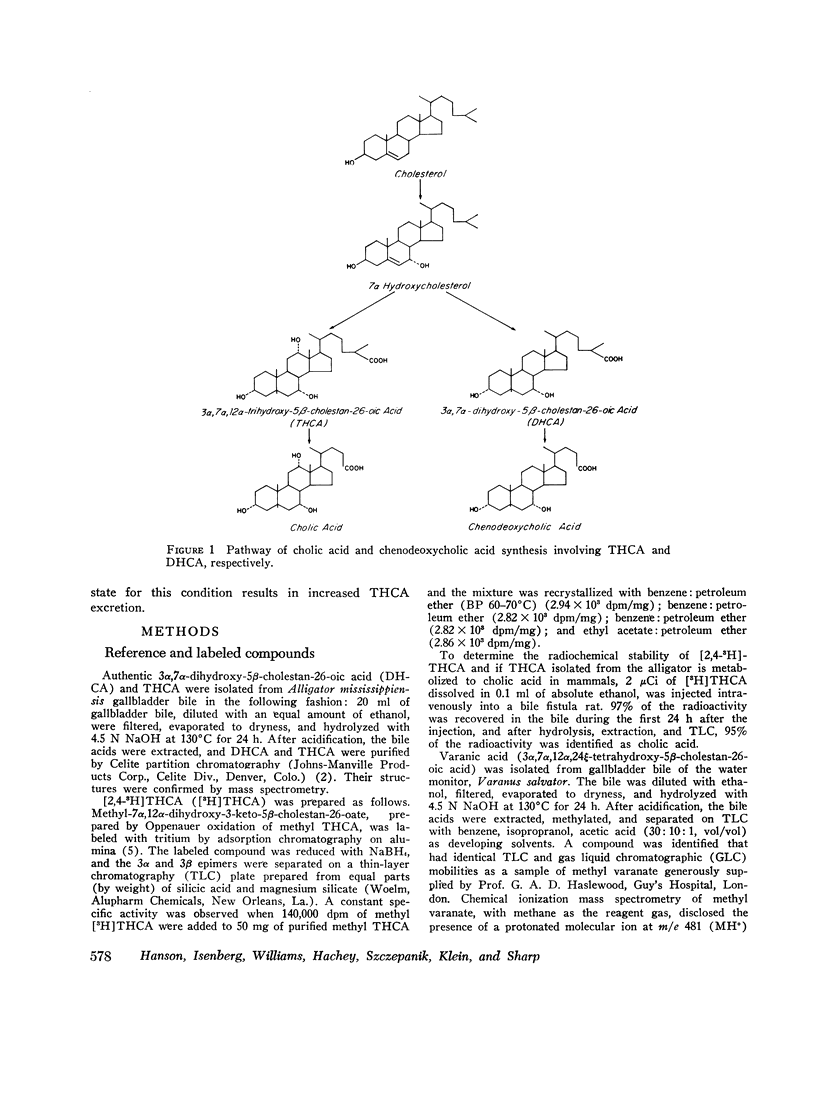
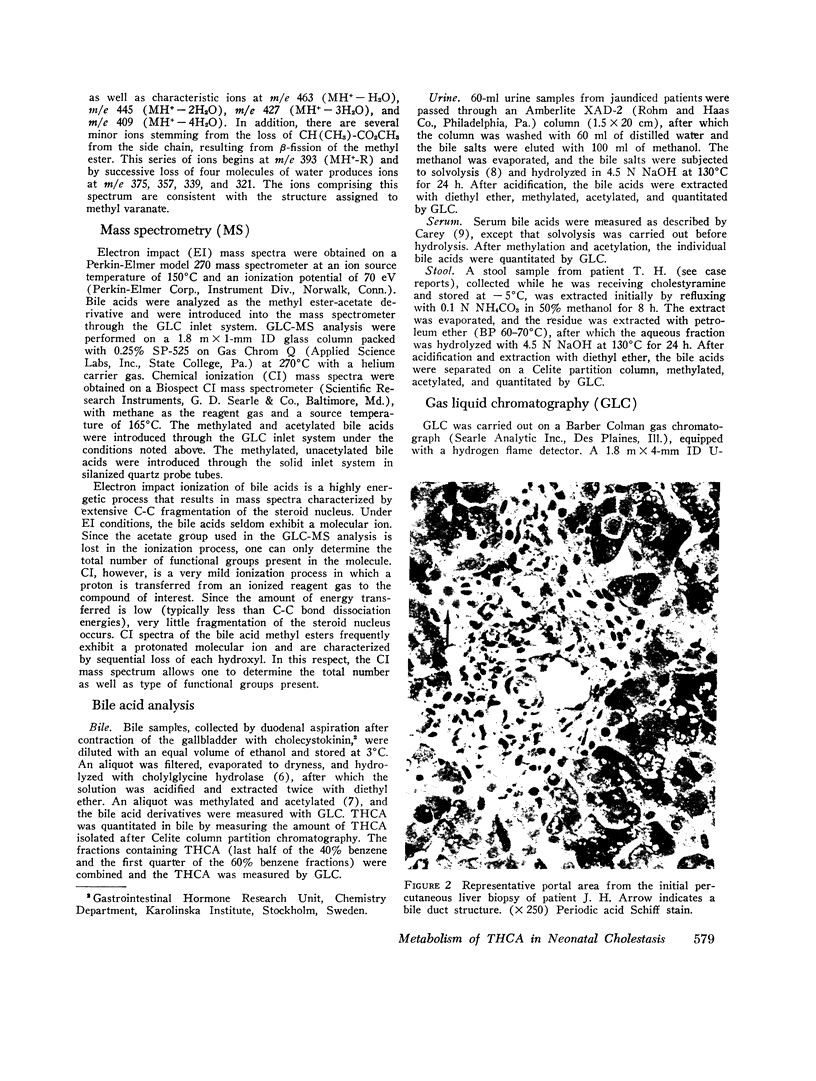
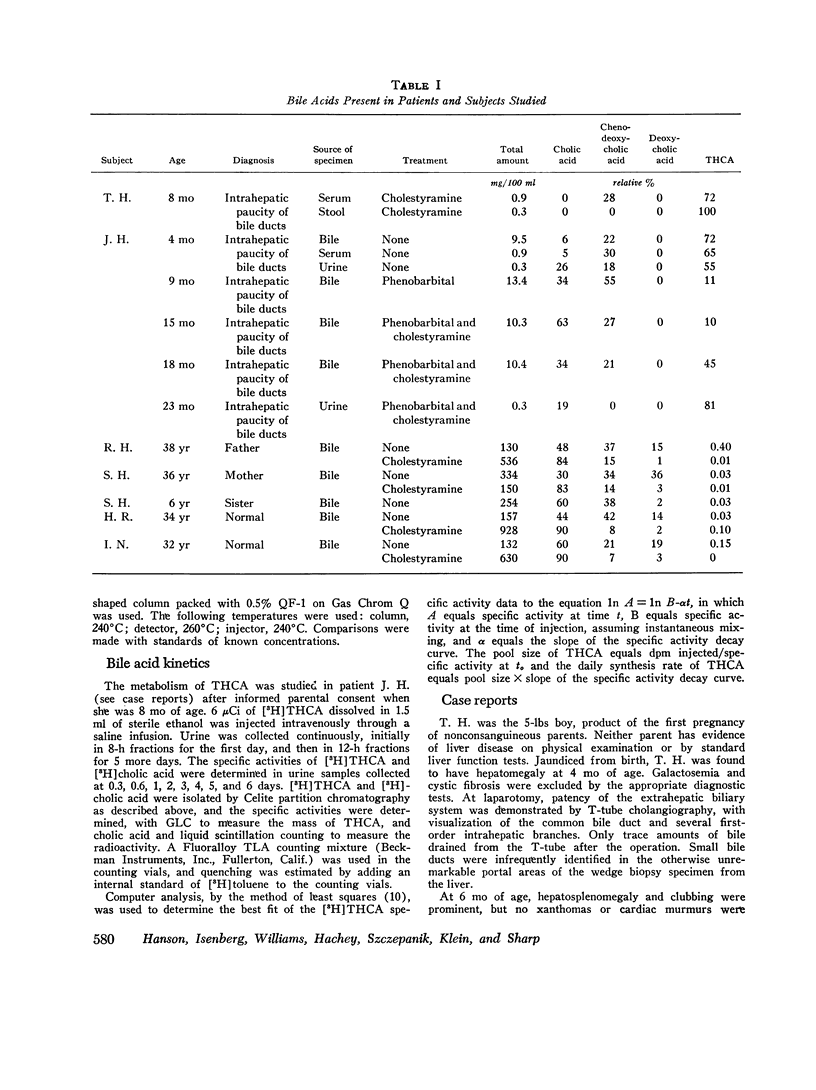
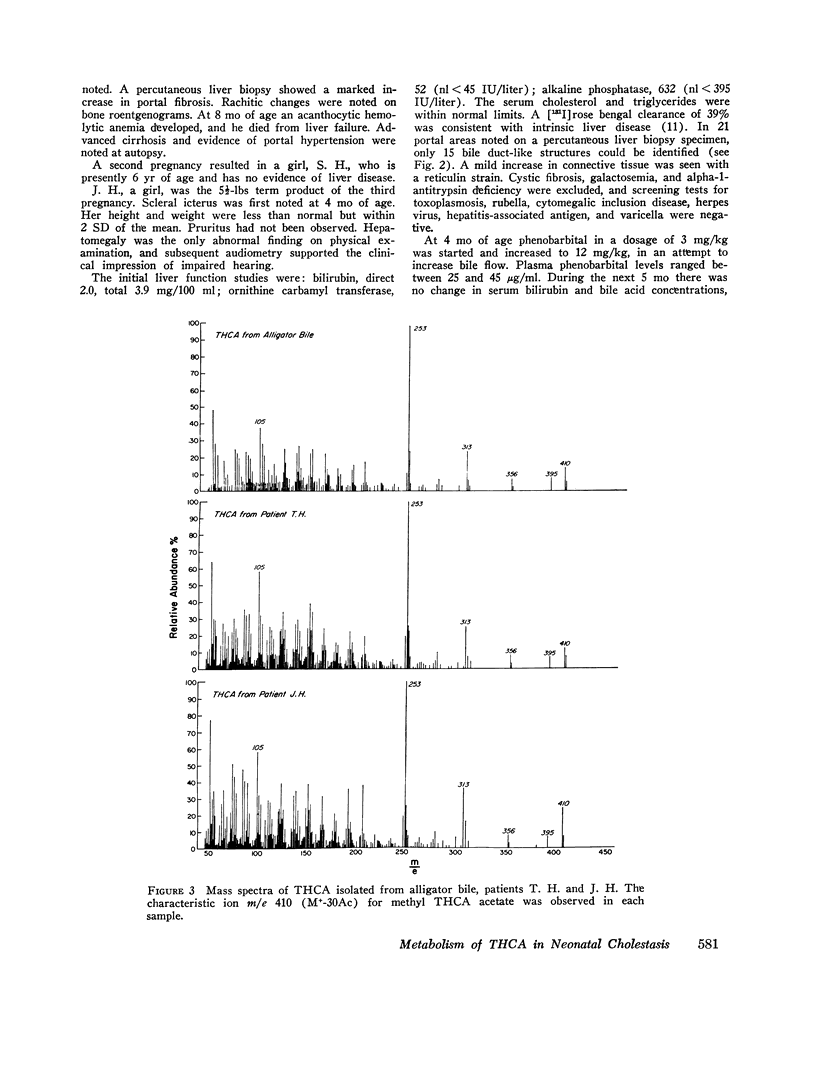
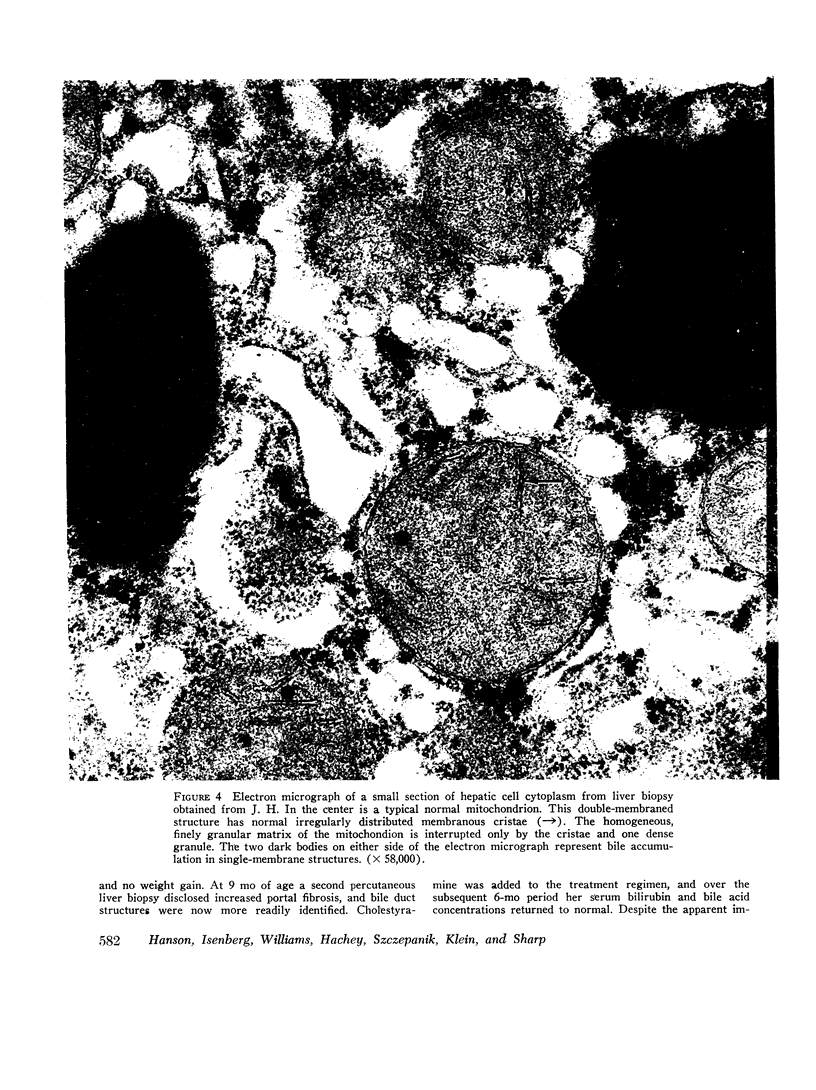
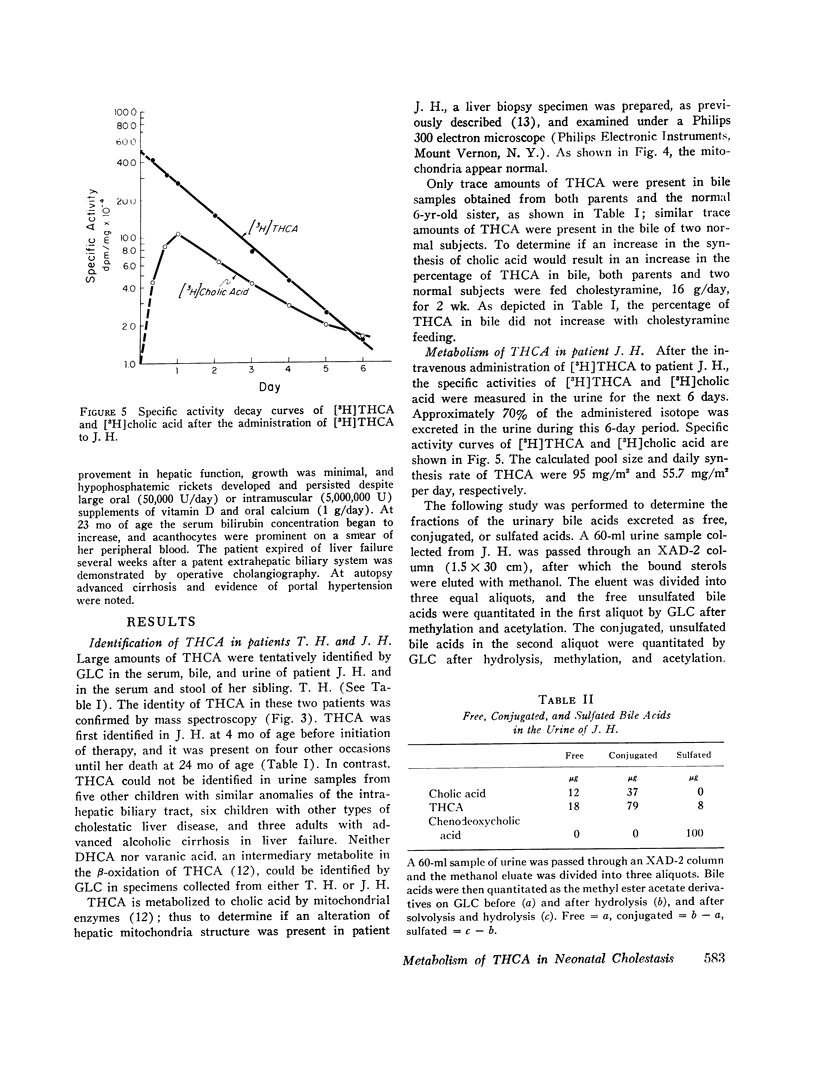
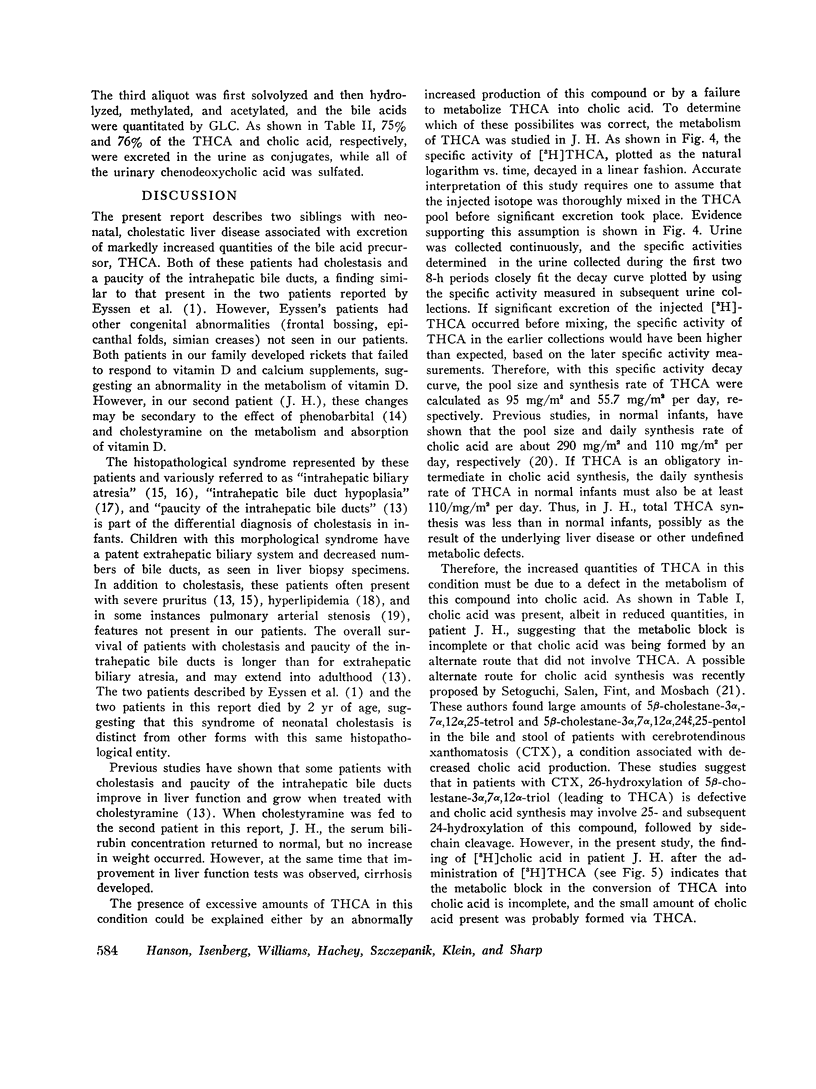
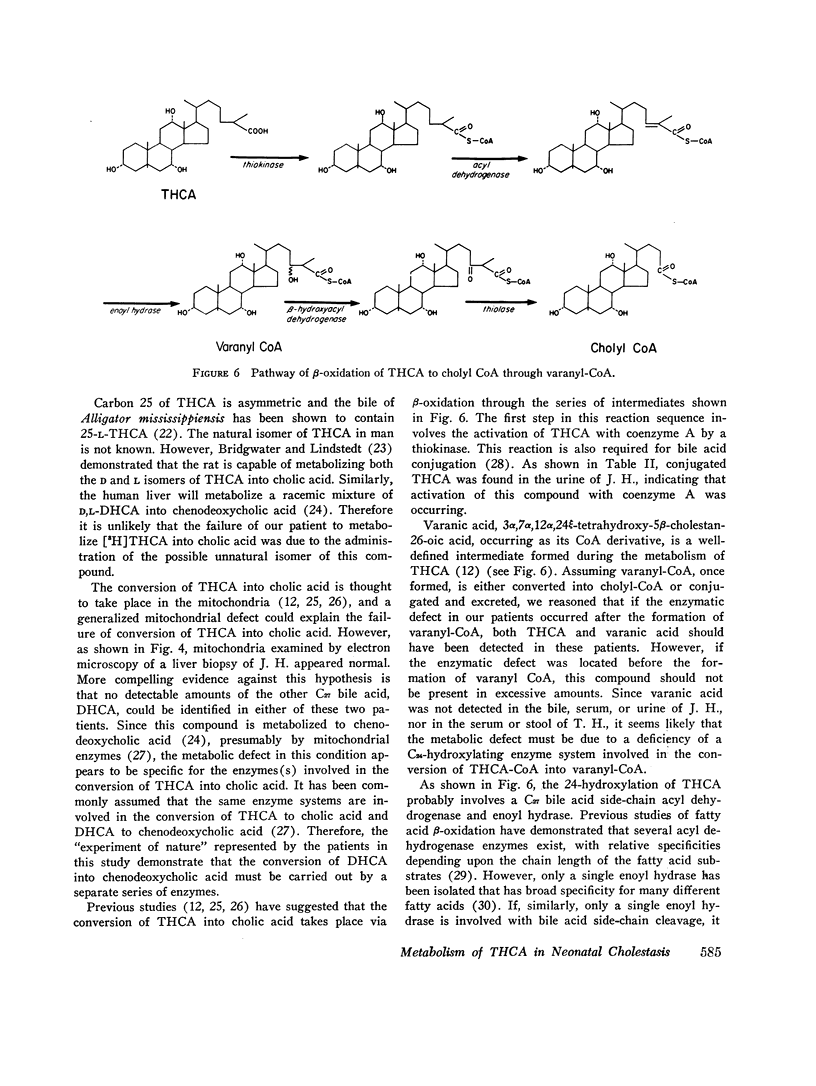
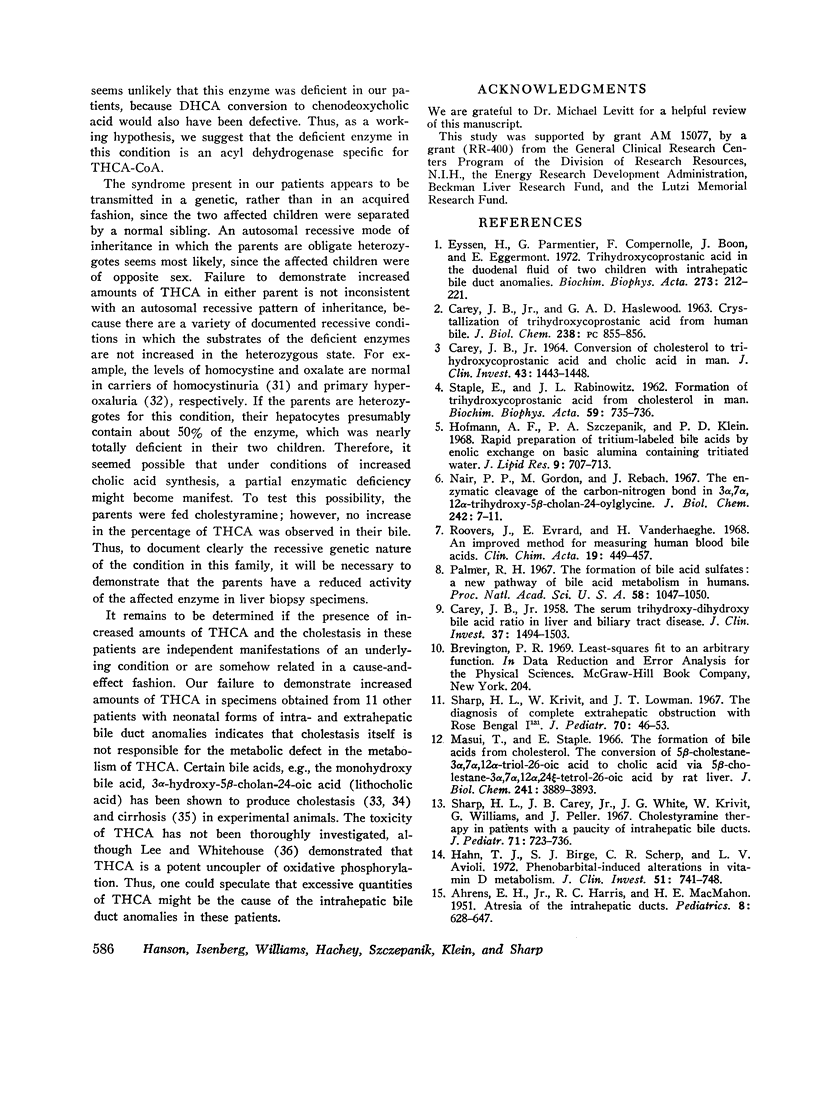
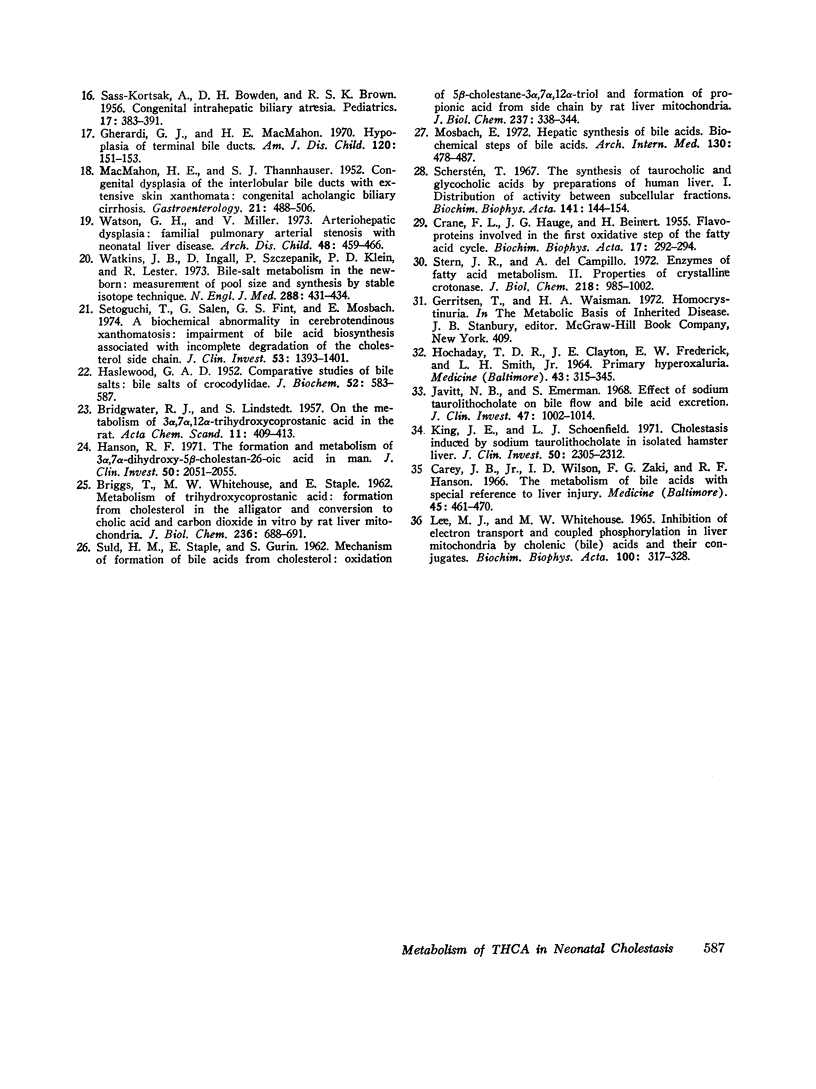
Images in this article
Selected References
These references are in PubMed. This may not be the complete list of references from this article.
- AHRENS E. H., Jr, HARRIS R. C., MacMAHON H. E. Atresia of the intrahepatic dile ducts. Pediatrics. 1951 Nov;8(5):628–647. [PubMed] [Google Scholar]
- CAREY J. B., Jr CONVERSION OF CHOLESTEROL TO TRIHYDROXYCOPROSTANIC ACID AND CHOLIC ACID IN MAN. J Clin Invest. 1964 Jul;43:1443–1448. doi: 10.1172/JCI105020. [DOI] [PMC free article] [PubMed] [Google Scholar]
- CAREY J. B., Jr, HASLEWOOD G. A. Crystallization of trihydroxycoprostani acid from human bile. J Biol Chem. 1963 Feb;238:855–856. [PubMed] [Google Scholar]
- CAREY J. B., Jr The serum trihydroxy-dihydroxy bile acid ratio in liver and biliary tract disease. J Clin Invest. 1958 Nov;37(11):1494–1503. doi: 10.1172/JCI103741. [DOI] [PMC free article] [PubMed] [Google Scholar]
- CRANE F. L., HAUGE J. G., BEINERT H. Flavoproteins involved in the first oxidative step of the fatty acid cycle. Biochim Biophys Acta. 1955 Jun;17(2):292–294. doi: 10.1016/0006-3002(55)90374-7. [DOI] [PubMed] [Google Scholar]
- Eyssen H., Parmentier G., Compernolle F., Boon J., Eggermont E. Trihydroxycoprostanic acid in the duodenal fluid of two children with intrahepatic bile duct anomalies. Biochim Biophys Acta. 1972 Jun 26;273(1):212–221. doi: 10.1016/0304-4165(72)90209-7. [DOI] [PubMed] [Google Scholar]
- Gherardi G. J., MacMahon H. E. Hypoplasia of terminal bile ducts. Am J Dis Child. 1970 Aug;120(2):151–153. doi: 10.1001/archpedi.1970.02100070095013. [DOI] [PubMed] [Google Scholar]
- HASLEWOOD G. A. D. Comparative studies of bile salts. V. Bile salts of Crocodylidae. Biochem J. 1952 Dec;52(4):583–587. doi: 10.1042/bj0520583. [DOI] [PMC free article] [PubMed] [Google Scholar]
- HOCKADAY T. D., CLAYTON J. E., FREDERICK E. W., SMITH L. H., Jr PRIMARY HYPEROXALURIA. Medicine (Baltimore) 1964 May;43:315–345. doi: 10.1097/00005792-196405000-00010. [DOI] [PubMed] [Google Scholar]
- Hahn T. J., Birge S. J., Scharp C. R., Avioli L. V. Phenobarbital-induced alterations in vitamin D metabolism. J Clin Invest. 1972 Apr;51(4):741–748. doi: 10.1172/JCI106868. [DOI] [PMC free article] [PubMed] [Google Scholar]
- Hanson R. F. The formation and metabolism of 3 ,7 -dihydroxy-5 -cholestan-26-oic acid in man. J Clin Invest. 1971 Oct;50(10):2051–2055. doi: 10.1172/JCI106698. [DOI] [PMC free article] [PubMed] [Google Scholar]
- Hofmann A. F., Szczepanik P. A., Klein P. D. Rapid preparation of tritium-labeled bile acids by enolic exchange on basic alumina containing tritiated water. J Lipid Res. 1968 Nov;9(6):707–713. [PubMed] [Google Scholar]
- Javitt N. B., Emerman S. Effect of sodium taurolithocholate on bile flow and bile acid exeretion. J Clin Invest. 1968 May;47(5):1002–1014. doi: 10.1172/JCI105790. [DOI] [PMC free article] [PubMed] [Google Scholar]
- King J. E., Schoenfield L. J. Cholestasis induced by sodium taurolithocholate in isolated hamster liver. J Clin Invest. 1971 Nov;50(11):2305–2312. doi: 10.1172/JCI106728. [DOI] [PMC free article] [PubMed] [Google Scholar]
- LEE M. J., WHITEHOUSE M. W. INHIBITION OF ELECTRON TRANSPORT AND COUPLED PHOSPHORYLATION IN LIVER MITOCHONDRIA BY CHOLANIC (BILE) ACIDS AND THEIR CONJUGATES. Biochim Biophys Acta. 1965 May 4;100:317–328. doi: 10.1016/0304-4165(65)90001-2. [DOI] [PubMed] [Google Scholar]
- MacMAHON H. E., THANNHAUSER S. J. Congenital dysplasia of the interlobular bile ducts with extensive skin xanthomata; congenital acholangic biliary cirrhosis. Gastroenterology. 1952 Aug;21(4):488–506. [PubMed] [Google Scholar]
- Masui T., Staple E. The formation of bile acids from cholesterol. The conversion of 5-beta-cholestane-3-alpha,7-alpha-triol-26-oic acid to cholic acid via 5-beta-cholestane-3-alpha,7-alpha,12-alpha, 24-xi-tetraol-26-oic acid I by rat liver. J Biol Chem. 1966 Sep 10;241(17):3889–3893. [PubMed] [Google Scholar]
- Mosbach E. H. Hepatic synthesis of bile acids. Biochemical steps and mechanisms of rate control. Arch Intern Med. 1972 Oct;130(4):478–487. [PubMed] [Google Scholar]
- Nair P. P., Gordon M., Reback J. The enzymatic cleavage of the carbon-nitrogen bond in 3-alpha, 7-alpha, 12-alpha-trihydroxy-5-beta-cholan-24-oylglycine. J Biol Chem. 1967 Jan 10;242(1):7–11. [PubMed] [Google Scholar]
- Palmer R. H. The formation of bile acid sulfates: a new pathway of bile acid metabolism in humans. Proc Natl Acad Sci U S A. 1967 Sep;58(3):1047–1050. doi: 10.1073/pnas.58.3.1047. [DOI] [PMC free article] [PubMed] [Google Scholar]
- Roovers J., Evrard E., Vanderhaeghe H. An improved method for measuring human blood bile acids. Clin Chim Acta. 1968 Mar;19(3):449–457. doi: 10.1016/0009-8981(68)90272-6. [DOI] [PubMed] [Google Scholar]
- SASS-KORTSAK A., BOWDEN D. H., BROWN R. J. Congenital intrahepatic biliary atresia. Pediatrics. 1956 Mar;17(3):383–391. [PubMed] [Google Scholar]
- STAPLE E., RABINOWITZ J. L. Formation of trihydroxycoprostanic acid from cholesterol in man. Biochim Biophys Acta. 1962 Jun 4;59:735–736. doi: 10.1016/0006-3002(62)90663-7. [DOI] [PubMed] [Google Scholar]
- STERN J. R., DEL CAMPILLO A. Enzymes of fatty acid metabolism. II. Properties of crystalline crotonase. J Biol Chem. 1956 Feb;218(2):985–1002. [PubMed] [Google Scholar]
- SULD H. M., STAPLE E., GURIN S. Mechanism of formation of bile acids from cholesterol: oxidation of 5bita-choles-tane-3alpha,7alpha,12alpha-triol and formation of propionic acid from the side chain by rat liver mitochondria. J Biol Chem. 1962 Feb;237:338–344. [PubMed] [Google Scholar]
- Scherstén T. The synthesis of taurocholic and glycocholic acids by preparations of human liver. I. Distribution of activity between subcellular fractions. Biochim Biophys Acta. 1967 Jun 13;141(1):144–154. [PubMed] [Google Scholar]
- Setoguchi T., Salen G., Tint G. S., Mosbach E. H. A biochemical abnormality in cerebrotendinous xanthomatosis. Impairment of bile acid biosynthesis associated with incomplete degradation of the cholesterol side chain. J Clin Invest. 1974 May;53(5):1393–1401. doi: 10.1172/JCI107688. [DOI] [PMC free article] [PubMed] [Google Scholar]
- Sharp H. L., Carey J. B., Jr, White J. G., Krivit W. Cholestyramine therapy in patients with a paucity of intrahepatic bile ducts. J Pediatr. 1967 Nov;71(5):723–736. doi: 10.1016/s0022-3476(67)80212-9. [DOI] [PubMed] [Google Scholar]
- Sharp H. L., Krivit W., Lowman J. T. The diagnosis of complete extrahepatic obstruction by rose bengal I-131. J Pediatr. 1967 Jan;70(1):46–53. doi: 10.1016/s0022-3476(67)80164-1. [DOI] [PubMed] [Google Scholar]
- Watkins J. B., Ingall D., Szczepanik P., Klein P. D., Lester R. Bile-salt metabolism in the newborn. Measurement of pool size and synthesis by stable isotope technic. N Engl J Med. 1973 Mar 1;288(9):431–434. doi: 10.1056/NEJM197303012880902. [DOI] [PubMed] [Google Scholar]
- Watson G. H., Miller V. Arteriohepatic dysplasia: familial pulmonary arterial stenosis with neonatal liver disease. Arch Dis Child. 1973 Jun;48(6):459–466. doi: 10.1136/adc.48.6.459. [DOI] [PMC free article] [PubMed] [Google Scholar]



